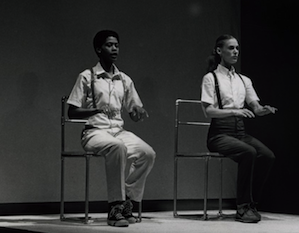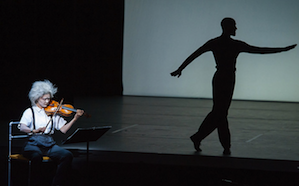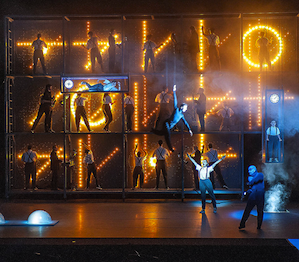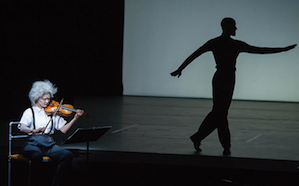
If everyone who claimed to have seen the original 1976 New York production of Robert Wilson and Philip Glass’ landmark opera Einstein on the Beach had really been there, perhaps the Metropolitan Opera would have scheduled another performance. And maybe the composer wouldn’t have been forced to drive a cab again after it was over, to pay off the six-figure loss incurred by the two Sunday night performances at the rented Met.
Revived twice since then, the four-act, 4½-hour pageant of images had never before played outside New York and Europe — until next weekend, that is, when it finally makes its West Coast premiere in three sold-out shows at UC Berkeley’s Zellerbach Hall, presented by Cal Performances. All three principal creators — composer Glass, director/designer Wilson, and choreographer Lucinda Childs — will participate in a panel discussion and master class settings.
Widely acknowledged as one of the milestones of 20th-century art, Einstein vaulted Glass and Wilson from avant-garde notoriety to worldwide celebrity, opening the door to further commissions and inaugurating a non-narrative, symbolic theatrical style that Wilson has continued to pursue. That historical significance is why so many arts lovers wish — or imagine — they’d been in the audience for those first American performances.

Yet, in many respects, Einstein remains sui generis, its ultimate influence on the arts still unclear. Moreover, unlike conventional theater and opera, where every director keeps the script but decides on different blocking, sets, and so on for each production, those aspects are really as inextricably part of Einstein‘s composition as the music or libretto. The nature of the movement and its interaction with the music were just as systematically determined by Wilson as other aspects of the production, even if he didn’t choreograph the details.
So what we’ll see in Berkeley is less a revival than a “re-creation” (to use Cal Performances Director Matías Tarnopolsky’s term) of, approximately, the 1984 production (which replaced some of the original choreography with movement designed by Lucinda Childs), plus a few new touches added by the original creators. It is probably the last time they’ll all be involved with their breakthrough masterpiece.
Which raises another question: Is this Einstein a period piece, frozen in its made-in-’70s-SoHo era, or does it have something new to say to 21st-century audiences?
Time Sensitive
“I think the work has a timeless quality,” insists Tarnopolsky, who never saw the earlier productions. “When I saw the first previews in Michigan, in January, I was struck by how it speaks to us today. It feels brand new and relevant and beautiful.”
Tarnopolsky and others involved in Einstein point to the work’s way of changing the perceptions of those who encounter it. “It’s hard to really find one particular way it has influenced works of its kind that came after it,” he says. “What’s really important in the work, and one element of its lasting influence, is the way it deals with time. It plays with your perception of time during the piece itself — how much time is passing, and how you’re engaged in the performance.”
“What’s really important in the work is the way it … plays with your perception of time.” – Matías Tarnopolsky, Cal Performances director
Some of those notions may have once seemed alien to American audiences, but not so to those familiar with some of the more ambitious productions staged in Europe. Choreographer Lucinda Childs views Einstein as a “bridge between the modern European theater and America.” “Through the lens of Robert Wilson, it begins to cross the ocean,” she says. That connection lends Einstein further historical importance.
Childs also notes that because Einstein doesn’t tell an explicit story, but rather proceeds in streams of music, movement, and sound, the opera allows “everybody to find their own connection.” For example, she remarks, “people who have seen it before have one sort of experience that’s different from those who have never seen it at all. But generally we find that the audiences tend to be attentive in a different way. Many of them are coming in thinking it’s some kind of serious, heavy classic, and there’s a lot of comedy that surprises people. Because it doesn’t force your full attention, you can look at different things at different times”: the images, the movement, the words, the music. Its capacity for open-ended individual interpretation makes Einstein permanently potent in a way a documentary about the physicist himself, say, might not be.
Formula-Breaking Inspiration

If Einstein on the Beach really were merely a historical artifact, you wouldn’t anticipate the effects Childs and Tarnopolsky mentioned to exert such a profound effect on one of the new production’s younger performers, Bay Area–based violinist Jennifer Koh.
In recent years, Koh had been wondering how to change the often-formulaic concert presentation of music, to offer “programmatic journeys” for the listeners. After the economic recession struck, she realized that the concert halls still teemed with people seeking the transformative experience of art.
“I wanted to create an experience where there was no strict boundary between performer and audience,” she explains. “I was thinking about how to create a larger, immersive experience for the audience. Einstein is the definition of that.” So when Tarnopolsky suggested that she participate in the its revival, Koh eagerly accepted, despite having never been involved in theater of any kind (“Which way is stage right?” she asked when instructed on which direction to move) — and despite the fact that this young Asian-American woman would play an old, Swiss-German man while wearing what turned out to be a very itchy wig.
After rehearsals started in January, “I fell in love with the way [Wilson] works and his vision,” she recalls. “It was like I found my artistic soul mate.” Koh particularly admired the director’s perfectionism and dedication. Despite his fame, which would allow him to rest on his many laurels, the 71-year-old director sometimes spent 18 hours at a stretch in the theater, she remembers. “He’s in it for the art. The way he works is incredibly beautiful and inspiring.”
“I always believed all the arts are connected, but now that’s no longer an abstract idea. Art is life-changing: So I don’t think of Einstein as history; it’s so relevant” – violinist Jennifer Koh
Koh also appreciated the director’s renowned ability to work with nonactors. He would tell her stories (“this scene is like Einstein’s dream,” for example, or “think of how oil and water push against each other but never quite merge into one element”), and those stories would inform her movement.
Changing Perception
Working with Wilson on Einstein revealed the key to the opera’s lasting impact, which Koh said works on someone from her generation who wasn’t even born when it premiered. She compares it to what can happen after attending an art exhibit, when you go outside and perceive forms and patterns that you didn’t before. “That’s what we hope to do as musicians,” she remarks: “Change your perception of piece so that it’s different than we thought it was. We find things within ourselves that we didn’t think were there. [Wilson] does that visually.
“I always believed all the arts are connected,” Koh continues. “But now that’s no longer an abstract idea. Art is life-changing — whether it’s how you perceive your world or your surroundings or music, it opens a new avenue and affects you emotionally. So I don’t think of [Einstein] as history, but as a living, breathing organism — definitely a living art form. It’s so relevant to today,” every bit as much as the Bach partitas and sonatas she plays often in recital.
In fact, Einstein‘s perception-changing power may be even more relevant to today’s multitasking, multimedia world than it was to the 1970s, Koh suggests, remembering her desire to create immersive experiences. “It used to be that you’d walk down the street and say hi to people,” Koh remembers. “Now, everybody’s busy texting. People are not as present or as still. I think one of the great things about going to something like Einstein is that it forces you to be present in the moment.”
That applies to her as a performer, as well. “That’s what I always hope to do,” she says, “whether in recitals or programs: being so present in every single performance, making that emotional connection with audience members.” Thanks to her experience with Einstein, Koh is already contemplating new kinds of performances, and perhaps future work with Wilson. Like its namesake’s still paradigm-changing notions of relativity, the ideas he and his co-creators pioneered in Einstein on the Beach apparently continue to reverberate down the decades and perhaps beyond.
There will be a panel/artist talk with Wilson, Glass, and Koh on Sun., Oct. 28, from 1–2 p.m.

